
-
Find the right food for your petTake this quiz to see which food may be the best for your furry friend.Find the right food for your petTake this quiz to see which food may be the best for your furry friend.Featured products
 Small & Mini Mature Adult 7+ Dog Food
Small & Mini Mature Adult 7+ Dog FoodHill's Science Plan Small & Mini Breed Mature Adult Dog Food with Chicken is a complete pet food, specially formulated with ActivBiome+ Multi-Benefit Technology.
Tailored nutrition to support graceful ageing in small dogs. Specially made with a synergistic blend of nutrients for energy & vigor.Shop Now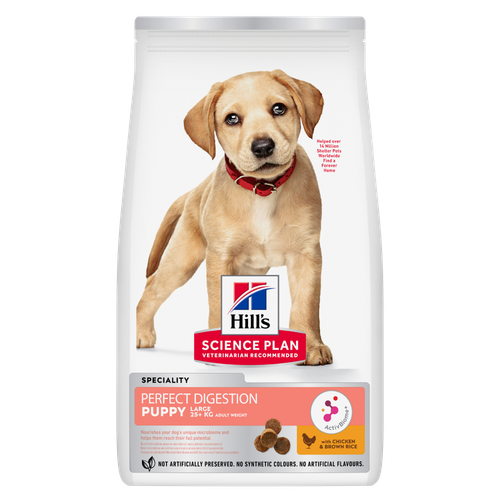 Perfect Digestion Large Breed Puppy Food
Perfect Digestion Large Breed Puppy FoodPrecisely balanced nutrition with Hill's ActivBiome+ prebiotic blend actively contributes to supporting digestive health and overall well-being to help your pet feel their best
Shop Now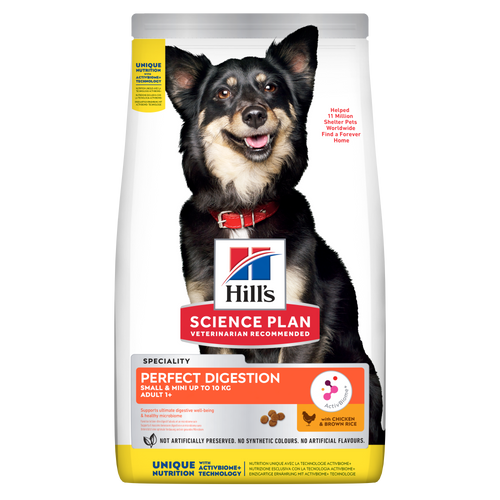 Perfect Digestion Small & Mini Adult Dog Food
Perfect Digestion Small & Mini Adult Dog FoodHill's Science Plan Perfect Digestion Small & Mini Breed Adult Dog Food with Chicken & Brown Rice supports ultimate digestive well-being & a healthy microbiome.
Shop NowFeatured products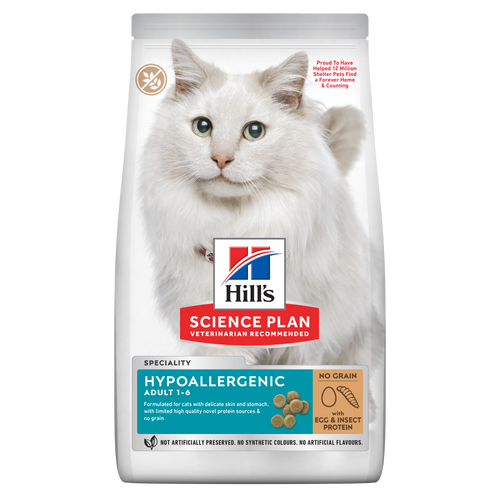 Hypoallergenic Dry Cat Food
Hypoallergenic Dry Cat FoodHILL'S SCIENCE PLAN Hypoallergenic Adult cat food with egg & insect protein is a complete pet food for adult cat 1–6 years old. It's formulated for cats with delicate skin and stomach, with limited high quality novel protein sources & no grain.
Shop Now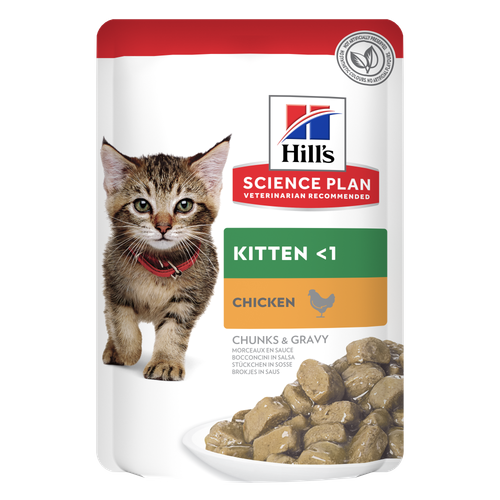 Kitten Food
Kitten FoodTender chicken chunks in gravy for kittens, with omega-3s for healthy eye & brain development and high-quality protein to support muscle growth. With balanced minerals to promote strong bones & teeth.
Shop Now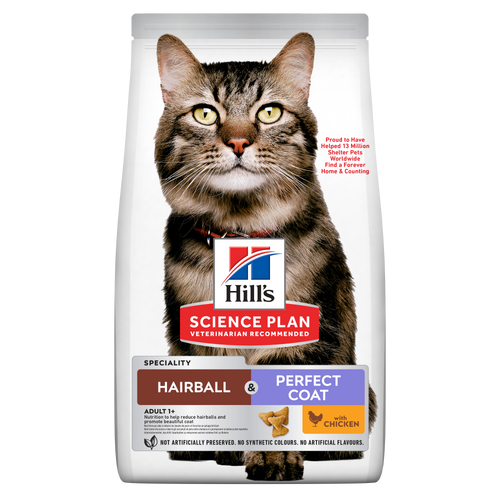 Hairball & Perfect Coat Adult Cat Food
Hairball & Perfect Coat Adult Cat FoodHill's Science Plan HAIRBALL & PERFECT COAT Adult cat food with Chicken is specially formulated to effectively help avoid hairball formation in adult cats while promoting a beautiful coat. Thanks to its mix of essential Omega-6 fatty acids, this food benefits the cat's skin and fur keeping them healthy and shiny. Our Advanced Fibre Technology helps reduce hairballs by naturally promoting their passage through the gut. This food is formulated with high-quality protein for a perfectly balanced, great-tasting recipe.
Shop Now -
Dog
- Dog Tips & Articles
-
Health Category
- Weight
- Food & Environmental Sensitivities
- Urinary
- Digestive
- Joint
- Kidney
-
Life Stage
- Puppy Nutrition
- Adult Nutrition
- Senior Nutrition
Cat- Cat Tips & Articles
-
Health Category
- Weight
- Skin & Food Sensitivities
- Urinary
- Digestive
- Kidney
-
Life Stage
- Kitten Nutrition
- Adult Nutrition
Featured articles Pet Food Storage Tips
Pet Food Storage TipsWhere you store your cat and dog food can make a big difference in the quality and freshness once it is opened. Here are some common questions and recommendations for optimal storage for all of Hill’s dry and canned cat and dog food.
Read More Understanding Your Pet's Microbiome
Understanding Your Pet's MicrobiomeLearn what a pet's microbiome is, how it contributes to your pet's gut & overall health, and why nutrition is important in maintaining healthy microbiomes.
Read More The Right Diet For Your Pet
The Right Diet For Your PetLearn what to look for in healthy pet food & nutrition, including ingredients, quality of the manufacturer, your pet's age, and any special needs they have
Read More -


Tooth Development
By three to four weeks of age your puppy’s temporary teeth, or milk teeth, will start to come through. They have 28 milk teeth in total. At around 3-4 months the milk teeth will start to come loose and fall out. They will then be replaced by their permanent teeth.
Puppies should lose their milk teeth before their adult teeth emerge. If your puppy’s teeth are still in place when an adult tooth begins to show, you’ll need to get advice from your vet.
The first permanent teeth to come through are usually the two centre teeth on the top jaw, and the last are the big corner or canine teeth in the top and bottom jaw. Most puppies will feel very little discomfort but may salivate more when the permanent teeth come through.
The average dog's mouth has 44 teeth. There are usually 22 on the top and 22 on the bottom. These teeth are divided into 8 upper and 6 lower incisors, 4 canines, 16 premolars, and 4 upper and 6 lower molars.


Tasty Tips
Dental Problems
Because bad teeth are very common in dogs, now's the time to start paying careful attention to them. Check your pet's teeth regularly, at least once a week, and look out for early warning signs; these include:
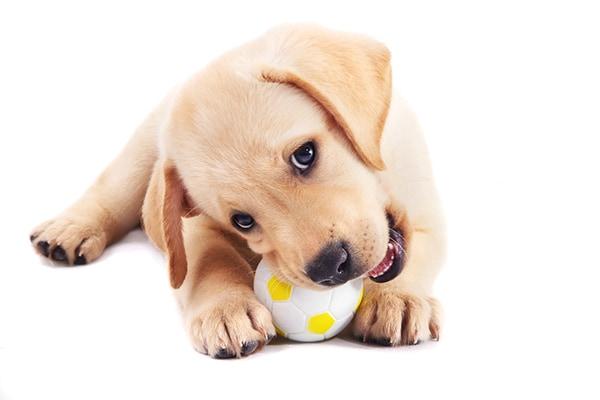
Bad breath
Bleeding gums
Build up of tartar and plaque on the teeth
Brushing your dog's teeth every day will go a long way towards preventing dental problems, so it's a good idea to start straight away. Ask your vet to recommend a dog toothpaste (human toothpaste is not suitable) and tooth brush.
How To Brush Your Dogs Teeth
Firstly make sure he's securely on his lead.
Position yourself and your puppy, so that you can have easy access to your puppy's mouth.
Put some toothpaste on your finger and allow him to lick it off then then start by gently massaging it onto his teeth.
Once he's used to this you can start using a dog toothbrush.
Gently pull back his lips and cheeks to gain access to the premolars and molars.
Brush in a circular motion, and be sure to brush where the tooth meets the gumline.
Try and get to the very back teeth, where teeth problems are most likely to develop.
It is important to keep your puppy calm and relaxed by praising him throughout.
Although this task may seem daunting initially, it becomes easier with practice and if your puppy gets used to it early in life it will become a simple task for you both.
As well as tooth brushing, there are special foods available that you can use to help keep your puppy’s teeth and gums healthy when he becomes an adult, like Hill’s™ Science Plan™ Oral Care. Specially formulated large dry kibbles are especially designed to wipe the teeth clean, helping to keep your pet's teeth free from plaque.


One of our staff authors prepared this article for you
Related products
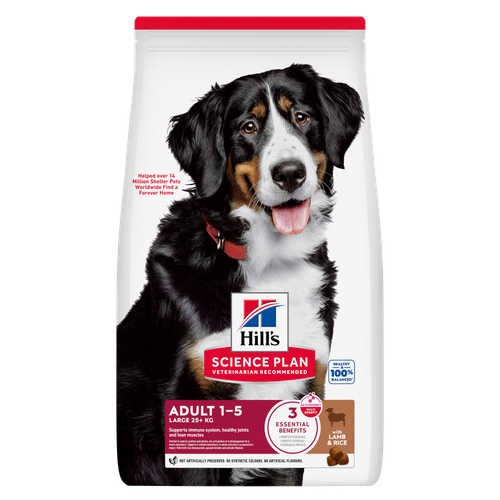
Hill's Science Plan Large Breed Adult Dog Food with Lamb & Rice is a complete pet food, specially formulated with ActivBiome+ Multi-Benefit Technology.
This food is specifically designed to fuel the energy needs of large breed dogs during the prime of their life.

Precisely balanced nutrition with Hill's ActivBiome+ prebiotic blend actively contributes to supporting digestive health and overall well-being to help your pet feel their best

Hill's Science Plan Perfect Digestion Small & Mini Breed Adult Dog Food with Chicken & Brown Rice supports ultimate digestive well-being & a healthy microbiome.

Hill's Science Plan Small & Mini Breed Mature Adult Dog Food with Chicken is a complete pet food, specially formulated with ActivBiome+ Multi-Benefit Technology.
Tailored nutrition to support graceful ageing in small dogs. Specially made with a synergistic blend of nutrients for energy & vigor.
Related articles

Discover the causes, signs, and treatments of kidney disease in dogs and find methods of supporting your dog's kidney health. Learn more at Hill's Pet South Africa.

Learn about snake bites on dogs, including clinical symptoms to look for, what to do if you think your dog was bitten, and treatment & prevention options.

Dog obesity is a significant problem - learn more about helping your dog become trimmer and healthier through improved nutrition.

Discover how the field of dog science is giving us more and more insights into the inner workings of our furry best friends.

Put your dog on a diet without them knowing
Our low calorie formula helps you control your dog's weight. It's packed with high-quality protein for building lean muscles, and made with purposeful ingredients for a flavorful, nutritious meal. Clinically proven antioxidants, Vitamin C+E, help promote a healthy immune system.
Put your dog on a diet without them knowing
Our low calorie formula helps you control your dog's weight. It's packed with high-quality protein for building lean muscles, and made with purposeful ingredients for a flavorful, nutritious meal. Clinically proven antioxidants, Vitamin C+E, help promote a healthy immune system.

